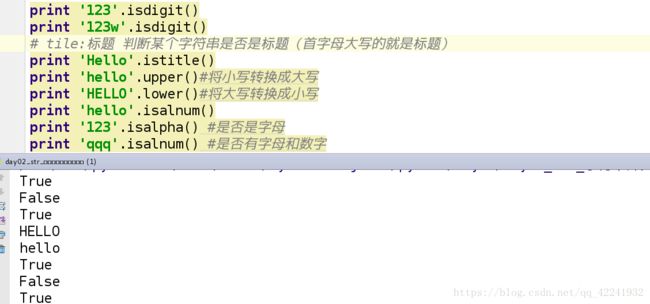学习Python之路之字符串的使用及各种案例
一、字符串的定义方式
a = "hello"
b = 'westos'
c = "what's up"
d = """
用户管理
1.添加用户
2.删除用户
3.显示用户
"""
print a
print b
print c
print d
二、字符串的特性
1.索引
索引:0,1,2,3,4……索引值是从0开始的
例如:
s = 'hello'
print s[0]
print s[1]2.切片
切片的规则:s[start:end:step] 从start开始到end-1结束,步长为:step
例如:
s = 'hello'
print s[0:3]
print s[0:4:2]
- 显示所有字符 :s[:]
- 显示前3个字符:s[:3]
- 对字符串倒叙输出:s[::-1]
- 除第一个字符以外,其他全部显示:s[1:]
3.重复
例如:将字符串“hello”显示十次
s ='hello'
print s * 10 4.连接
例如 :将字符串‘hello’和‘world’连接起来
print 'hello ' + 'world'5.成员操作符
s='hello'
print 'q' in s
print 'he' in s
print 'aa' in s三、字符串的用法
1.字符串的统计
例如:
print 'helloooo'.count('o')2.字符串的搜索和替换
搜索:find:找到字符串,并返回最小的索引
替换:replace
s = 'hello world'
print len(s)
print s.find('hello')
print s.find('world')
print s.replace('hello','westos')3.字符串的分离和连接
1)分离
例如:
s = '172.25.254.250'
s1 = s.split('.')
print s1
date = '2018-8-27'
date1 = date.split('-')
print date12)连接
例如:
date = '2018-8-27'
date1 = date.split('-')
print date1
print ''.join(date1)
print '/'.join(date1)
print '/'.join('hello')4.字符串开头和结尾匹配
例如:
s = 'hello.jpg'
print s.endswith('.png') # 找出字符串是否以XXX结尾
url1 = 'http://www.baidu.com'
url2 = 'file:///mnt'
print url1.startswith('http://')
print url2.startswith('f')5.字符串判断是否是大小写、数字或是标题
判断类型时,若有一个元素不满足,就返回False
print '123'.isdigit()
print '123w'.isdigit()
# tile:标题 判断某个字符串是否是标题(首字母大写的就是标题)
print 'hello'.istitle()
print 'Hello'.istitle()
print 'hello'.upper()#将小写转换成大写
print 'HELLO'.lower()#将大写转换成小写
print 'hello'.isalnum()
print '123'.isalpha() #是否是字母
print '123'.isalnum()
print 'qqq'.isalnum() #是否有字母和数字
四、字符串的练习题
示例【1】:输入一行字符,统计其中有多少个单词,每两个单词之间以空格隔开,如输入:This is a c++ program.输出:There are 5 words in the line
a = raw_input('请输入一行英文字符:')
li = a.split()
b = len(li)
print 'There are %d words in the line' % b
示例【2】:给出一个字符串,在程序中赋初值为一个句子,例如“he threw three free throws”,自编函数完成下面的功能:求出字符列表中字符的个数(对于例句,输出为26)
a = raw_input('请输入一行字符:')
b = len(a)
print '%d' % b示例【3】:给定一个字符串来代表一个学生的出勤记录,这个记录仅包含以下三个字符:‘A’:Absent,缺勤 ‘L’:Late,迟到 ‘P’:Present,到场,如果一个学生的出勤记录中不超过一个‘A’(缺勤)并且不超过两个连续的‘L’(迟到),那么,这个学生会被奖赏。示例1:输入:"PPALLP"输出:True 示例2:输入:“PPALLL” 输出False
s = str(raw_input('学生的出勤记录'))
if (s.count('A') <= 1 and s.count('LLL') == 0):
print 'True'
else:
print 'False'示例【4】:判断一个数是否是回文数。例如:输入:121,输出也是121,像这样的数就是回文数
num = raw_input('Num:')
if num == num[::-1]:
print 'True'
else:
print 'False'
示例【5】:打印菱形
n = int(raw_input('Num:'))
for i in range(1,n):
print ('*' * i).center(n,' ')
for i in range(n,0,-1):
print ('*' * i).center(n,' ')

















